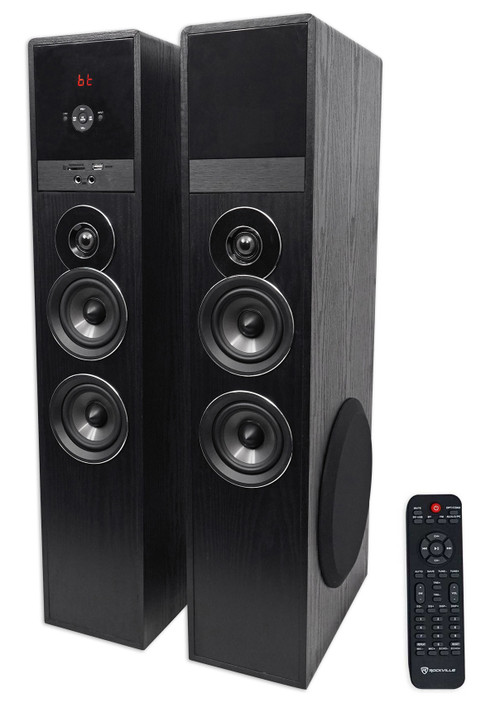Most of what I'm talking about relates to any OS. ( Windows, Mac, BSD, or even ... Linux )
Most PCs come with something called an Aux output. This gets a little bit tricky.
My main PC for example, has pink, green and blue 3.5mm ( sometimes called 1/8 mini audio jack )
Auxillary ports on the back of my case, it also has another one on the top of my case. So four in all
on this computer case. The pink one is for a microphone. The green one goes out to my speakers normally.
The blue one accepts "line input". For example I could use it record music from another PC without
using a microphone. The one on the top of my case is similar to the green one on the back of my case.
I can connect PC speakers, or a headphone to that jack as well. Normally when you plug something into
the headphone jack, it disables the speaker output port on the back of my PC.
I would guess over 95% of PCs come this way, and usually stay this way. But there are other options.
Something that has become more popular over the last few years, are small desktop speakers ( usually fairly low power )
that can be plugged into one of your USB ports. Usually these do not AC power cords, as they are powered by the
USB port on your PC. I've never a set of these USB powered speakers that had a very high output. Normally less
than 5 watts.
USB speakers normally take digital input, and Auxillary port speakers are normally analog ( also spelled as analogue )
Normally all 3.5mm 1/8 inch speaker ports are analog. I've never seen one that wasn't.
In my case, I use this audio controller.
 Audio device: Advanced Micro Devices, Inc. [AMD] Starship/Matisse HD Audio Controller
Audio device: Advanced Micro Devices, Inc. [AMD] Starship/Matisse HD Audio Controller
It's not bad. It's not great, in fact I would grade it as "average", as far as auxillary sound ports go.
This is actually a Realtek ALC1200 chipset. That supports something called 7.1 sound.
This is a great site, if you're into that kind of thing... https://www.igorslab.de/en/realtek-...-is-really-different-from-the-larger-alc1220/
I don't want to get tooooo caught up in technical specs here, but I do want to mention a few.
There are few companies that make sound cards for PCs. Probably the most well known company is
Creative Labs, who makes the Sound Blaster cards. There are internal sound cards that plug into PCIe slots, and external
cards that usually plug into a USB port ( either USB type A or USB type C ). When you look at these cards to buy them,
You will often see something like...
Most axillary analog ports only support 16bit/192kHz. So even if you are paying a site like Tidal.com money
for higher resolution audio files. You're only going to hear them with as good of quality as your PC supports.
I know there are illegal ways of getting music files and downloading them, but that isn't what this article is about.
My main point here is, even if you have $10,000 speakers, but they're getting input directly from your PC's aux port.
You're likely only going to hear 16-bit 196kHz music. Now unless you're a musician (I'm a drummer in a band )
or an audiophile, you may not be able to hear the difference. In my case, I can definitely hear the difference.
Option two is, just go from one of your USB ports to a USB speaker. If you don't mind low volume, these
are usually powered by the USB port from your computer and don't need a power cord. The sound of these
speakers can be slightly better than your aux port speakers.
An example of this would be...
Option three. These are still USB input speakers, but they are AC powered.
Some examples of these would be...
 www.behringer.com
www.behringer.com

 www.rockvilleaudio.com
www.rockvilleaudio.com
The sound quality will be noticeably better than your aux port with any of these speakers. Some can get quite loud. I found
one model that was over 400 watts.
I actually have a couple of computers that do not have a 3.5mm 1/8 inch speaker port at all on them. So USB speakers are
really my only viable option for them. (They are in a small NUC type case, and will not accept a PCIe sound card )
Option four, buy a SPDIF/Toslink adapter for your PC. As mentioned earlier these come as internal PCIe cards or external
USB boxes. They come from fairly cheap ( less than $30.00US to over $300.00US ) The higher the audio specs,the higher
the price of the card. Generally 32-bit/384kHz is about as good as your going to get. You don't have to buy the most expensive
cards to get those numbers, some of the mid-range cards are virtually as good.
Now you will get even better sound from your PC, but the downside is... you need to buy speakers that support Optical
SPDIF/Toslink input. These speakers usually cost a little more. Usually over $100.00US for a pair.
This is the setup I have. I don't actually use that sound-card I mentioned earlier, even though my motherboard came with it.
Finally option 5. HDMI output.
If you have a HDMI video card that has two video out ports ( either display port or HDMI ). You can use one of the HDMI
ports that isn't connected to your monitor for audio out. Usually the only speakers that support HDMI input are typically
soundbars for television. If you by a discrete stereo head ( Think Denon, Sony, Pioneer, etc.. ) these will usually have
an HDMI sound input port. The best sound quality you can get these days. Is via HDMI. For me, I usually can't hear
the difference between HDMI and optical, so optical is good enough for me.
I need to talk more about the actual sound files themselves, but I'm out of time tonight.
The main six that you usually see are .wav, .mp3, m4a, mkv, opus, and webm. Some support higher resolutions than others.
So even if you have the best sound system, but the audio file was encoded in 16-bit/128kHz.. you're only going to get
what the audio file was made with. Most of these sound formats support up 48000hz.
I'll add a line here to remind me to talk about Pipewire also.
Most PCs come with something called an Aux output. This gets a little bit tricky.
My main PC for example, has pink, green and blue 3.5mm ( sometimes called 1/8 mini audio jack )
Auxillary ports on the back of my case, it also has another one on the top of my case. So four in all
on this computer case. The pink one is for a microphone. The green one goes out to my speakers normally.
The blue one accepts "line input". For example I could use it record music from another PC without
using a microphone. The one on the top of my case is similar to the green one on the back of my case.
I can connect PC speakers, or a headphone to that jack as well. Normally when you plug something into
the headphone jack, it disables the speaker output port on the back of my PC.
I would guess over 95% of PCs come this way, and usually stay this way. But there are other options.
Something that has become more popular over the last few years, are small desktop speakers ( usually fairly low power )
that can be plugged into one of your USB ports. Usually these do not AC power cords, as they are powered by the
USB port on your PC. I've never a set of these USB powered speakers that had a very high output. Normally less
than 5 watts.
USB speakers normally take digital input, and Auxillary port speakers are normally analog ( also spelled as analogue )
Normally all 3.5mm 1/8 inch speaker ports are analog. I've never seen one that wasn't.
In my case, I use this audio controller.

AMD Starship/Matisse HD Audio Controller
A database of all the hardware that works under linux
linux-hardware.org
It's not bad. It's not great, in fact I would grade it as "average", as far as auxillary sound ports go.
This is actually a Realtek ALC1200 chipset. That supports something called 7.1 sound.
This is a great site, if you're into that kind of thing... https://www.igorslab.de/en/realtek-...-is-really-different-from-the-larger-alc1220/
I don't want to get tooooo caught up in technical specs here, but I do want to mention a few.
There are few companies that make sound cards for PCs. Probably the most well known company is
Creative Labs, who makes the Sound Blaster cards. There are internal sound cards that plug into PCIe slots, and external
cards that usually plug into a USB port ( either USB type A or USB type C ). When you look at these cards to buy them,
You will often see something like...
32-bit/384 kHz or 24-bit/256 kHz or 16-bit/192 kHz
The higher the bits and the higher the sampling rate, the better the card ( and the more expensive ).Most axillary analog ports only support 16bit/192kHz. So even if you are paying a site like Tidal.com money
for higher resolution audio files. You're only going to hear them with as good of quality as your PC supports.
I know there are illegal ways of getting music files and downloading them, but that isn't what this article is about.
My main point here is, even if you have $10,000 speakers, but they're getting input directly from your PC's aux port.
You're likely only going to hear 16-bit 196kHz music. Now unless you're a musician (I'm a drummer in a band )
or an audiophile, you may not be able to hear the difference. In my case, I can definitely hear the difference.
Option two is, just go from one of your USB ports to a USB speaker. If you don't mind low volume, these
are usually powered by the USB port from your computer and don't need a power cord. The sound of these
speakers can be slightly better than your aux port speakers.
An example of this would be...
Option three. These are still USB input speakers, but they are AC powered.
Some examples of these would be...
Behringer | Not Found

Rockville TM80B Black Home Theater System Tower Speakers 8" Sub/Bluetooth/USB
Buy Rockville TM80B Black Home Theater System Tower Speakers 8" Sub/Bluetooth/USBDirect with a 90 day money back guarantee including return shipping
 www.rockvilleaudio.com
www.rockvilleaudio.com
The sound quality will be noticeably better than your aux port with any of these speakers. Some can get quite loud. I found
one model that was over 400 watts.
I actually have a couple of computers that do not have a 3.5mm 1/8 inch speaker port at all on them. So USB speakers are
really my only viable option for them. (They are in a small NUC type case, and will not accept a PCIe sound card )
Option four, buy a SPDIF/Toslink adapter for your PC. As mentioned earlier these come as internal PCIe cards or external
USB boxes. They come from fairly cheap ( less than $30.00US to over $300.00US ) The higher the audio specs,the higher
the price of the card. Generally 32-bit/384kHz is about as good as your going to get. You don't have to buy the most expensive
cards to get those numbers, some of the mid-range cards are virtually as good.
Now you will get even better sound from your PC, but the downside is... you need to buy speakers that support Optical
SPDIF/Toslink input. These speakers usually cost a little more. Usually over $100.00US for a pair.
This is the setup I have. I don't actually use that sound-card I mentioned earlier, even though my motherboard came with it.
Finally option 5. HDMI output.
If you have a HDMI video card that has two video out ports ( either display port or HDMI ). You can use one of the HDMI
ports that isn't connected to your monitor for audio out. Usually the only speakers that support HDMI input are typically
soundbars for television. If you by a discrete stereo head ( Think Denon, Sony, Pioneer, etc.. ) these will usually have
an HDMI sound input port. The best sound quality you can get these days. Is via HDMI. For me, I usually can't hear
the difference between HDMI and optical, so optical is good enough for me.
I need to talk more about the actual sound files themselves, but I'm out of time tonight.
The main six that you usually see are .wav, .mp3, m4a, mkv, opus, and webm. Some support higher resolutions than others.
So even if you have the best sound system, but the audio file was encoded in 16-bit/128kHz.. you're only going to get
what the audio file was made with. Most of these sound formats support up 48000hz.
I'll add a line here to remind me to talk about Pipewire also.

